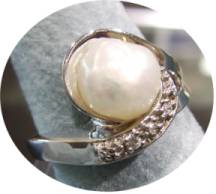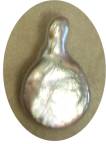|
Tennessee River Pearls
|
 |
This ring is made from a natural Tennessee River pearl.
In 1901 pearling excitement developed in the mountain regions of eastern Tennessee, especially in Clinch River. These newly-discovered resources proved so valuable that the local interest became very great. Vivid and picturesque accounts published in the local papers reported hundreds of persons as camping at various points along the streams, some in tents and some in rough shanties, and others going from shoal to shoal in newly-built house-boats. They were described as easy-going, pleasure-loving people, the men, women, and children working hard all day, subsisting largely on fish caught in the same stream, and dancing at night to the music of a banjo around the camp-fires. The center of the new industry was Clinton, the county seat of Anderson County, whither the successful hunters betook themselves each Saturday, the preferred time for selling the catch.
Historic USA Pearling Centers
The pearls are collected for the trade by a score or more of buyers, who visit the fisheries at intervals and purchase of the individual fishermen by personal dickering and bargaining. The buyers endeavor to keep informed of all choice pearls discovered, and when an especially valuable find is reported each one endeavors to have the first chance to secure it. The principal local centers of the pearling industry adn marketing are Prairie du Chien, Wisconsin; McGregor, Clinton, and Muscatine, Iowa; Newport, Black Rock, and Balk Knob, Arkansas; Clinton, Carthage, and Smithville, Tennessee; St. Francisville, Illinois; and Vincennes and Leavenworth, Indiana.
Aboriginal Pearls
Prof. Joseph Jones, whose investigations throw much valuable light upon the contents of the ancient tumuli of Tennessee, says: "I do not remember finding a genuine pearl in the many mounds which I have opened in the valleys of the Tennessee, the Cumberland, the Harpeth, and elsewhere. Many of the pearls described by the Spaniards were probably little else than polished beads cut out of large sea-shells and from the thicker portions of fresh-water mussels, and prepared so as to resemble pearls. I have examined thousands of these, and they all present a laminated structure, as if carved out of thick shells and sea conchs."
Dr. Charles Rau writes: "I learned from Dr. Samuel G. Bristow, who was a surgeon in the Army of the Cumberland during the Civil War, that mussels of the Tennessee River were occasionally eaten 'as a change' by the soldiers of that corps, and pronounced no bad article of diet. Shells of the Unio are sometimes found in Indian graves, where they had been deposited with the dead, to serve as food during the journey to the land of spirits."
Dr. Brinton saw on the Tennessee River and its tributries numberous shell-heaps consisting almost exclusively of the Unio virginianus. In every instance he found shell-heaps close to the water courses, on the rich alluvial bottom-land. He says: "The mollusks had evidently been opened by placing them on a fire. The Tennessee mussel is margaritiferous, and there is no doubt but that it was from this species that the early tribes obtained the hoards of pearls which the historian of De Soto's explorations estimated by bushels, and which were so much prized as ornaments."
More about aboriginal pearls with photos.
Search here.







